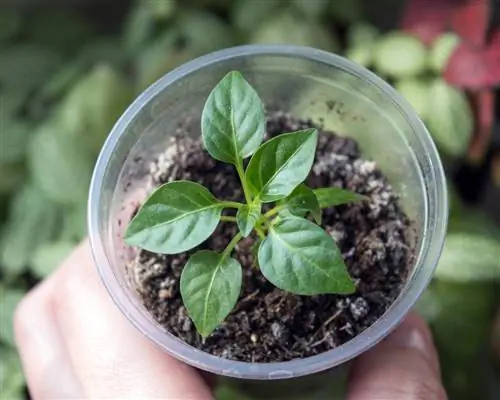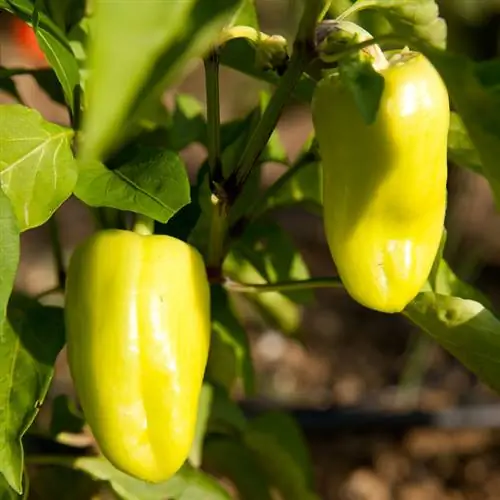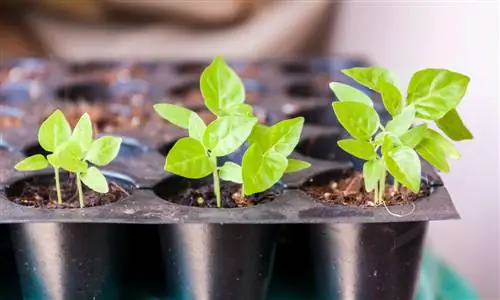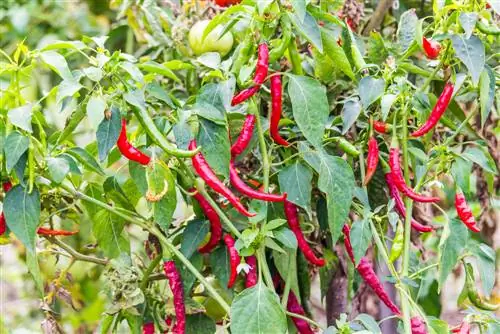- Author admin [email protected].
- Public 2023-12-16 16:46.
- Last modified 2025-01-23 11:21.
Every second person now has tomatoes or herbs in their garden. How about some pepperoni? If planted appropriately, you can expect a rich harvest in late summer. Here you will find valuable tips on how to proceed.

How should you plant and care for hot peppers?
To plant pepperoni successfully, cultivation should begin in January and the plants should be planted in nutrient-rich, permeable and slightly acidic garden soil after the Ice Saints (May 15th). A sunny location protected from wind and rain promotes the growth and subsequent harvest of the fruit.
The cultivation
First of all, decide whether you want to buy a hot pepper from a specialist store that has already been grown, or whether you want to grow the plant from seeds right from the start. You will receive cuttings from the nursery from around February. Seeds can also be bought everywhere. Alternatively, take the seeds from an older, dry hot pepper pod. While you can plant a cutting straight away in the garden soil, you have to germinate the seeds in a spring pot. With enough water and enough sunlight, the first shoots will form after a short time. Ideally, you should start growing from seeds in January.
It depends on the variety
Please note that there are annual and perennial pepperoni varieties. You can safely cultivate annual specimens in the vegetable patch. For perennial plants, you should consider keeping them in pots. Hot peppers do not tolerate frost and must be kept indoors over the winter. A container makes transport easier, otherwise you have to dig up the plant before the first frost and plant it in a container for the winter.
The right time
Peppers do not tolerate temperatures below 5°C. When planting, you will be on the safe side if you wait until there is no longer any threat of night frost. A common deadline is May 15th, when the Ice Saints have passed.
The Floor
Peperoni are relatively undemanding. However, with the right soil you promote growth and ultimately also the yield when the fruits are harvested later. The optimal soil condition is characterized by the following criteria:
- permeable so that no waterlogging forms
- nutrient-rich garden soil
- under no circumstances pre-fertilized soil
- constantly moist soil
- Enriched with horn meal (€6.00 on Amazon) or compost
- slightly acidic to neutral (pH value 0, 3-4, 6)
The Location
Peperoni plants are actually very undemanding. However, they place certain requirements on the location:
- bright and sunny
- no drafts
- warm (definitely above 10°C)
- sheltered from the wind
- rainproof
- Whether it's in a bucket or in the ground doesn't matter
- small greenhouses also offer protection and store additional heat
Protection from weeds
To avoid annoying weed growth around the peppers, a mulching film helps. This also offers the advantage that the earth beneath it warms up, which benefits the growth of your pepperoni. When laying out, proceed as follows:
- 1. clear the relevant area of weeds
- 2.loosen the soil
- 3. Lay out foil
- 4. Cut slits into the foil
- 5. Place plants in the slots
Planting hot peppers in the ground
When ultimately planting, you must be careful not to plant your peppers too deep or too shallow in the soil. Orientate yourself on the depth that you have already used in the cultivation pot. If you would like to grow several hot peppers at the same time, we recommend a planting distance of 40 to 50 cm between the individual plants. If you lay them out in rows, you should maintain a distance of 50 to 60 cm between each row. By the way, when your pepperoni bears fruit, it will look very nice if you mix several varieties in the bed. The different species get along very well, even when laid out in a colorful manner.
Tip
So that the initially fragile shoots do not break in strong winds, a support helps. A simple stick (e.g. bamboo) can be used for this, on which your pepperoni can climb high.






